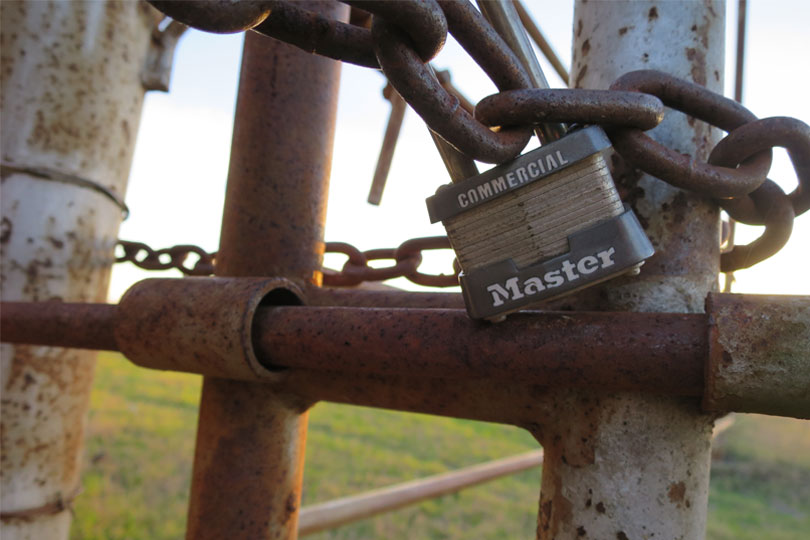By Jessica Domel
Multimedia Reporter
You head out to the pasture or pens and something is just not right. A few cows are missing or the horses aren’t where they normally are. A lock is cut. What do you do first?
According to Scott Williamson, special ranger and Region 1 supervisor for the Texas and Southwestern Cattle Raisers Association (TSCRA), the first things you do after noticing a theft can make a big difference in your chances of recovery.
“If you pull up there and see a gate cut, instead of driving in, driving around and looking to see what happened, it’s critical that you take that time to back up and call law enforcement. Tire tracks, foot prints, cigarette butts, cans and anything that could be in there may be destroyed by that producer driving in,” Williamson said. “You gain the advantage of being able to have a chance to recover that evidence if you’re flagged by a cut lock or a removed lock.”
Call local law enforcement and your TSCRA special ranger, if you can, he said.
“I suggest calling both,” Williamson said. “Both are critical. Most likely, they will communicate anyway, but that allows for the best information sharing.”
Branding, using ear tags and keeping a good record of what you are raising and where also helps in aiding the recovery of stolen livestock.
“One of the next best processes is just a crime watch mentality. It’s been implemented in urban areas for years, and it happens in rural. It just doesn’t always get facilitated to the proper authorities,” Williamson said. “When I work criminal cases, particularly if there’s multiple offenses in that investigation, it’s very common that I find a rancher that says, ‘You know what? I saw that pickup. I wondered what he was doing here.’ But he never told anybody.”
Know your neighbors. Keep in contact with them. Most importantly, if you see something, say something. At the very least, write down anything suspicious you may see.
Williamson suggests keeping a calendar or datebook with a pen in the visor to ensure you have details long after the fact.
“If you’re driving along and a producer sees a red Dodge with Oklahoma plates or Kansas plates and he’s thinking, ‘Man, where’d that dude come from?’ Instead of just thinking that, take just a second, pull down your calendar book and write, ‘Feb. 9 or Feb. 10, 10 a.m., red Dodge, brown trailer, two cattle panels on it, a black cow in the back or just a horse,” Williamson said.
Even if you cannot get an entire license plate, law enforcement officials can use state and national databases to narrow down their search for a suspect.
“Many of our crimes are solved by someone calling in and saying, ‘Listen, I just saw this and this, and it’s not right,’” Williamson said.
Not all stolen livestock are being sold through sale barns where TSCRA special rangers are often checking brands. Thieves have gone high-tech.
“We’ve worked cattle that are actually traded for narcotics and that are sold through Facebook. We’ve seen them sold through Craigslist, go to sale barns, and laundered through buyers or laundered into a legitimate set of cattle,” Williamson said.
TSCRA posts thefts on its Facebook and Twitter pages hoping someone may have information to help solve a case. Williamson said it’s the little details that can sometimes mean the difference between a rancher seeing his livestock again or not.
“It is a beneficial tool, and we have recovered quite a few items from that,” Williamson said. “We’re working lots of property crime nowadays on top of our livestock—tractors, trailers—but as much as anything it’s guns and smaller equipment. A lot of times these are tied back to narcotics crimes. People are either on narcotics just trying to make enough money to make another purchase, or we’re actually finding the cartel is involved with even the Aryan Brotherhood at stealing property and firearms, trading them back for cash and narcotics.”
Farmers and ranchers alike are encouraged to write down serial numbers for guns and other equipment and keep it in a safe place in the event something is stolen. Without a serial number or marking, law enforcement cannot search for the stolen item in crime databases.
“So mark those numbers, photograph them,” Williamson said. “On saddles and other items, if you will take your driver’s license number, preface


Sophisticated hog traps ( cameras, solar panels, controls, cell phone equipment, etc.) are become favorite targets also. There are reports of being stolen so fast that inside jobs become suspect.